Composite Materials Based on Gelatin and Iron Oxide Nanoparticles for MRI Accuracy
Abstract
1. Introduction
2. Materials and Methods
2.1. Materials
2.2. Preparation Methods
2.2.1. Preparation of Gelatin-Based Materials
2.2.2. Preparation of G, G–Fe2O3 and G–Fe3O4 Materials
2.3. Characterization Techniques
2.3.1. Fourier Transform Infrared Spectroscopy
2.3.2. Contact Angle and Surface Wettability Study
2.3.3. Scanning Electron Microscopy (SEM) Analysis-EDAX
2.3.4. Optical Properties
2.3.5. Determination of Dynamic Vapors’ Sorption and Diffusion Coefficients
2.3.6. Determination of Tensile Properties
2.3.7. Magnetic Determination
2.3.8. Biological Test
Cytocompatibility—MTT Assay
Antibacterial Test
3. Results and Discussion
3.1. FTIR and ATR-FTIR Analysis
3.2. Surface Morphology and Hydrophobicity
3.3. Optical Properties
3.4. Tensile Properties
3.5. Investigation of Water Vapors Sorption Capacity of Gelatin-Based Material Using the Dynanic Vapor Sorption (DVS) Measurements
Diffusion Coefficients
3.6. Magnetic Properties
3.7. Cytocompatibility—MTT Assay
3.8. Antibacterial Test
4. Conclusions
Supplementary Materials
Author Contributions
Funding
Institutional Review Board Statement
Informed Consent Statement
Data Availability Statement
Acknowledgments
Conflicts of Interest
References
- Shih, H.; Lin, C.-C. Photoclick hydrogels prepared from functionalized cyclodextrin and poly(ethylene glycol) for drug delivery and in situ cell encapsulation. Biomacromolecules 2015, 16, 1915–1923. [Google Scholar] [CrossRef] [PubMed]
- Li, Y.; Maciel, D.; Rodrigues, J.; Shi, X.; Tomás, H. Biodegradable polymer nanogels for drug/nucleic acid delivery. Chem. Rev. 2015, 115, 8564–8608. [Google Scholar] [CrossRef] [PubMed]
- Soppimath, K.S.; Aminabhavi, T.M.; Kulkarni, A.R.; Rudzinski, W.E. Biodegradable polymeric nanoparticles as drug delivery devices. J. Control. Release 2001, 70, 1–20. [Google Scholar] [CrossRef]
- Su, J.; Chen, F.; Cryns, V.L.; Messersmith, P.B. Catechol polymers for pH-responsive, targeted drug delivery to cancer cells. J. Am. Chem. Soc. 2011, 133, 11850–11853. [Google Scholar] [CrossRef] [PubMed]
- Kumar, S.; Singh, S.; Senapati, S.; Singh, A.P.; Ray, B.; Maiti, P. Controlled drug release through regulated biodegradation of poly(lactic acid) using inorganic salts. Int. J. Biol. Macromol. 2017, 104, 487–497. [Google Scholar] [CrossRef] [PubMed]
- Shim, M.S.; Kwon, Y.J. Stimuli-responsive polymers and nanomaterials for gene delivery and imaging applications. Adv. Drug Deliv. Rev. 2012, 64, 1046–1059. [Google Scholar] [CrossRef]
- Mo, R.; Jiang, T.; Gu, Z. Recent progress in multidrug delivery to cancer cells by liposomes. Nanomedicine 2014, 9, 1117–1120. [Google Scholar] [CrossRef]
- Abdulrachman, D.; Thongkred, P.; Kocharin, K.; Nakpathom, M.; Somboon, B.; Narumol, N.; Champreda, V.; Eurwilaichitr, L.; Suwanto, A.; Nimchua, T.; et al. Heterologous expression of Aspergillus aculeatus endo-polygalacturonase in Pichia pastoris by high cell density fermentation and its application in textile scouring. BMC Biotechnol. 2017, 17, 15. [Google Scholar] [CrossRef][Green Version]
- Gu, F.X.; Karnik, R.; Wang, A.; Alexis, F.; Levy-Nissenbaum, E.; Hong, S.; Langer, R.S.; Farokhzad, O.C. Targeted nanoparticles for cancer therapy. Nano Today 2007, 2, 14–21. [Google Scholar] [CrossRef]
- Sun, W.; Gu, Z. Engineering DNA scaffolds for delivery of anticancer therapeutics. Biomater. Sci. 2015, 3, 1018–1024. [Google Scholar] [CrossRef]
- Niazvand, F.; Cheshmi, A.; Zand, M.; NasrAzadani, R.; Kumari, B.; Raza, A.; Nasibi, S. An overview of the development of composites containing Mg and Zn for drug delivery. J. Compos. Compd. 2020, 2, 193–204. [Google Scholar] [CrossRef]
- Kudaibergenov, S.E. Macromolecular complexes of polyampholytes. Pure Appl. Chem. 2019, 92, 839–857. [Google Scholar] [CrossRef]
- Kudaibergenov, S.E.; Ciferri, A. Natural and synthetic polyampholytes. Macromol. Rapid Commun. 2007, 28, 1969–1986. [Google Scholar] [CrossRef]
- Silva, A.C.Q.; Silvestre, A.J.D.; Vilela, C.; Freire, C.S.R. Natural polymers-based materials: A contribution to a greener future. Molecules 2021, 27, 94. [Google Scholar] [CrossRef]
- Kudaibergenov, S.E. Synthetic and natural polyampholytes: Structural and behavioral similarity. Polym. Adv. Technol. 2020, 32, 906–918. [Google Scholar] [CrossRef]
- Sharifi, S.; Islam, M.M.; Sharifi, H.; Islam, R.; Koza, D.; Reyes-Ortega, F.; Alba-Molina, D.; Nilsson, P.H.; Dohlman, C.H.; Mollnes, T.E.; et al. Tuning gelatin-based hydrogel towards bioadhesive ocular tissue engineering applications. Bioact. Mater. 2021, 6, 3947–3961. [Google Scholar] [CrossRef]
- Khan, S.; Anwar, N. Gelatin/carboxymethyl cellulose based stimuli-responsive hydrogels for controlled delivery of 5-fluorouracil, development, in vitro characterization, in vivo safety and bioavailability evaluation. Carbohydr. Polym. 2021, 257, 117617. [Google Scholar] [CrossRef]
- Cassano, R.; Curcio, F.; Mandracchia, D.; Trapani, A.; Trombino, S. Gelatin and glycerine-based bioadhesive vaginal hydrogel. Curr. Drug Deliv. 2020, 17, 303–311. [Google Scholar] [CrossRef]
- Kimura, A.; Jo, J.-I.; Yoshida, F.; Hong, Z.; Tabata, Y.; Sumiyoshi, A.; Taguchi, M.; Aoki, I. Ultra-small size gelatin nanogel as a blood brain barrier impermeable contrast agent for magnetic resonance imaging. Acta Biomater. 2021, 125, 290–299. [Google Scholar] [CrossRef]
- Lewandowska-Łańcucka, J.; Fiejdasz, S.; Rodzik, Ł.; Kozieł, M.; Nowakowska, M. Bioactive hydrogel-nanosilica hybrid materials: A potential injectable scaffold for bone tissue engineering. Biomed. Mater. 2015, 10, 015020. [Google Scholar] [CrossRef]
- Heo, D.N.; Ko, W.-K.; Bae, M.S.; Lee, J.B.; Lee, D.-W.; Byun, W.; Lee, C.H.; Kim, E.-C.; Jung, B.-Y.; Kwon, I.K. Enhanced bone regeneration with a gold nanoparticle–hydrogel complex. J. Mater. Chem. B 2014, 2, 1584–1593. [Google Scholar] [CrossRef] [PubMed]
- Capanema, N.S.V.; Carvalho, I.; Mansur, A.A.P.; De Carvalho, S.M.; Lage, A.P.; Mansur, H.S. Hybrid hydrogel composed of carboxymethylcellulose–silver nanoparticles–doxorubicin for anticancer and antibacterial therapies against melanoma skin cancer cells. ACS Appl. Nano Mater. 2019, 2, 7393–7408. [Google Scholar] [CrossRef]
- Kloster, G.A.; Muraca, D.; Londoño, O.M.; Pirota, K.R.; Mosiewicki, M.A.; Marcovich, N.E. Alginate based nanocomposites with magnetic properties. Compos. Part A Appl. Sci. Manuf. 2020, 135, 105936. [Google Scholar] [CrossRef]
- Mayer, C.R.; Cabiiil, V.; Lalot, T.; Tlioiivenot, R. Magnetic nanoparticles trapped in pH 7 hydrogels as a tool to characterize the properties of the polymeric network. Adv. Mater. 2000, 12, 417–420. [Google Scholar] [CrossRef]
- Furlan, D.M.; Morgado, D.; de Oliveira, A.J.; Faceto, D.; de Moraes, D.A.; Varanda, L.C.; Frollini, E. Sisal cellulose and magnetite nanoparticles: Formation and properties of magnetic hybrid films. J. Mater. Res. Technol. 2019, 8, 2170–2179. [Google Scholar] [CrossRef]
- Indoliya, A.; Mohan, M.; Kharey, P.; Gupta, S.; Poddar, R. Polymerically modified superparamagnetic iron oxide nanoparticles as a multi-model molecular probe for functionalized optical coherence tomography. Opt. Laser Technol. 2021, 141, 107108. [Google Scholar] [CrossRef]
- Sudimack, J.; Lee, R.J. Targeted drug delivery via the folate receptor. Adv. Drug Deliv. Rev. 2000, 41, 147–162. [Google Scholar] [CrossRef]
- Jordan, A.; Scholz, R.; Maier-Hauff, K.; Johannsen, M.; Wust, P.; Nadobny, J.; Schirra, H.; Schmidt, H.; Deger, S.; Loening, S.; et al. Presentation of a new magnetic field therapy system for the treatment of human solid tumors with magnetic fluid hyperthermia. J. Magn. Magn. Mater. 2001, 225, 118–126. [Google Scholar] [CrossRef]
- Nishio, K.; Ikeda, M.; Gokon, N.; Tsubouchi, S.; Narimatsu, H.; Mochizuki, Y.; Sakamoto, S.; Sandhu, A.; Abe, M.; Handa, H. Preparation of size-controlled (30–100nm) magnetite nanoparticles for biomedical applications. J. Magn. Magn. Mater. 2006, 310, 2408–2410. [Google Scholar] [CrossRef]
- Gupta, A.K.; Gupta, M. Synthesis and surface engineering of iron oxide nanoparticles for biomedical applications. Biomaterials 2005, 26, 3995–4021. [Google Scholar] [CrossRef]
- Jun, Y.-W.; Lee, J.-H.; Cheon, J. Chemical design of nanoparticle probes for high-performance magnetic resonance imaging. Angew. Chem. Int. Ed. 2008, 47, 5122–5135. [Google Scholar] [CrossRef] [PubMed]
- Mahmoudi, M.; Sant, S.; Wang, B.; Laurent, S.; Sen, T. Superparamagnetic iron oxide nanoparticles (SPIONs): Development, surface modification and applications in chemotherapy. Adv. Drug Deliv. Rev. 2011, 63, 24–46. [Google Scholar] [CrossRef] [PubMed]
- Sirivat, A.; Paradee, N. Facile synthesis of gelatin-coated Fe3O4 nanoparticle: Effect of pH in single-step co-precipitation for cancer drug loading. Mater. Des. 2019, 181, 107942. [Google Scholar] [CrossRef]
- Ganapathe, L.S.; Mohamed, M.A.; Mohamad Yunus, R.; Berhanuddin, D.D. Magnetite (Fe3O4) nanoparticles in biomedical application: From synthesis to surface functionalisation. Magnetochemistry 2020, 6, 68. [Google Scholar] [CrossRef]
- Dutta, B.; Shelar, S.B.; Rajan, V.; Checker, S.; Barick, K.C.; Pandey, B.N.; Kumar, S.; Hassan, P.A. Gelatin grafted Fe3O4 based curcumin nanoformulation for cancer therapy. J. Drug Deliv. Sci. Technol. 2021, 67, 102974. [Google Scholar] [CrossRef]
- Basha, M.A. Optical properties and colorimetry of gelatine gels prepared in different saline solutions. J. Adv. Res. 2018, 16, 55–65. [Google Scholar] [CrossRef]
- Na, H.B.; Song, I.C.; Hyeon, T. Inorganic Nanoparticles for MRI Contrast Agents. Adv. Mater. 2009, 21, 2133–2148. [Google Scholar] [CrossRef]
- Feng, B.; Hong, R.; Wang, L.; Guo, L.; Li, H.; Ding, J.; Zheng, Y.; Wei, D. Synthesis of Fe3O4/APTES/PEG diacid functionalized magnetic nanoparticles for MR imaging. Colloids Surf. A Physicochem. Eng. Asp. 2008, 328, 52–59. [Google Scholar] [CrossRef]
- Gradinaru, L.M.; Mandru, M.B.; Drobota, M.; Aflori, M.; Butnaru, M.; Spiridon, M.; Doroftei, F.; Aradoaei, M.; Ciobanu, R.C.; Vlad, S. Composite materials based on iron oxide nanoparticles and polyurethane for improving the quality of MRI. Polymers 2021, 13, 4316. [Google Scholar] [CrossRef]
- Gradinaru, L.M.; Vlad, S.; Barbalata-Mandru, M.; Drobota, M.; Spiridon, M.; Aflori, M.; Butnaru, M.; Ionel, A.; Ciobanu, R.C. Polyurethane composites based on iron oxide nanoparticles as precursor in MRI. In Proceedings of the 2021 International Conference on e-Health and Bioengineering (EHB), Iasi, Romania, 17–18 November 2021; pp. 1–4. [Google Scholar] [CrossRef]
- Orive, G.; Ali, O.; Anitua, E.; Pedraz, J.; Emerich, D. Biomaterial-based technologies for brain anti-cancer therapeutics and imaging. Biochim. Biophys. Acta 2010, 1806, 96–107. [Google Scholar] [CrossRef]
- Akarçay, H.G.; Preisser, S.; Frenz, M.; Rička, J. Determining the optical properties of a gelatin-TiO2 phantom at 780 nm. Biomed. Opt. Express 2012, 3, 418–434. [Google Scholar] [CrossRef] [PubMed][Green Version]
- Leech, D.J.; Guy, W.; Klein, S. The polychromatic woodburytype—Colour tracking in translucent, patterned gelatin/pigment films. Molecules 2020, 25, 2468. [Google Scholar] [CrossRef] [PubMed]
- Gilchrist, S.; Kinchesh, P.; Zarghami, N.; Khrapitchev, A.A.; Sibson, N.R.; Kersemans, V.; Smart, S.C. Improved detection of molecularly targeted iron oxide particles in mouse brain using B0 field stabilised high resolution MRI. Magn. Reson. Imaging 2020, 67, 101–108. [Google Scholar] [CrossRef] [PubMed]
- Cao, N.; Fu, Y.; He, J. Mechanical properties of gelatin films cross-linked, respectively, by ferulic acid and tannin acid. Food Hydrocoll. 2007, 21, 575–584. [Google Scholar] [CrossRef]
- Chen, C.; Yang, H.; Yang, X.; Ma, Q. Tannic acid: A crosslinker leading to versatile functional polymeric networks: A review. RSC Adv. 2022, 12, 7689–7711. [Google Scholar] [CrossRef]
- Zhang, X.; Do, M.D.; Casey, P.; Sulistio, A.; Qiao, G.G.; Lundin, L.; Lillford, P.; Kosaraju, S. Chemical cross-linking gelatin with natural phenolic compounds as studied by high-resolution NMR spectroscopy. Biomacromolecules 2010, 11, 1125–1132. [Google Scholar] [CrossRef]
- Yang, Y.; Anvari, M.; Pan, C.-H.; Chung, D. Characterisation of interactions between fish gelatin and gum arabic in aqueous solutions. Food Chem. 2012, 135, 555–561. [Google Scholar] [CrossRef]
- Wang, J.; Fan, X.; Liu, H.; Tang, K. Self-assembly and metal ions-assisted one step fabrication of recoverable gelatin hydrogel with high mechanical strength. Polym. Technol. Mater. 2020, 59, 1899–1909. [Google Scholar] [CrossRef]
- Gradinaru, L.M.; Barbalata-Mandru, M.; Vlad, S.; Petrescu, M. Surface energy evaluation of casting and nanofiber polyurethane films by using different models. J. Appl. Polym. Sci. 2021, 138, 50834. [Google Scholar] [CrossRef]
- Barzic, A.I.; Albu, R.M.; Stoica, I.; Hulubei, C. New shielding covers based on transparent polyimide/ferrous sulfide composites that reduce optical losses in solar cells. Compos. Sci. Technol. 2021, 218, 109140. [Google Scholar] [CrossRef]
- Crank, J. The Mathematics of Diffusion, 2nd ed.; Clarendon Press: Oxford, UK, 1975; pp. 11–26. [Google Scholar]
- Mosmann, T. Rapid colorimetric assay for cellular growth and survival: Application to proliferation and cytotoxicity assays. J. Immunol. Methods 1983, 65, 55–63. [Google Scholar] [CrossRef]
- Vlad, M.D.; del Valle, L.J.; Poeata, I.; Barracó, M.; López, J.; Torres, R.; Fernández, E. Injectable iron-modified apatitic bone cement intended for kyphoplasty: Cytocompatibility study. J. Mater. Sci. Mater. Med. 2008, 19, 3575–3583. [Google Scholar] [CrossRef] [PubMed]
- Vlad, M.D.; Valle, L.J.; Poeată, I.; López, J.; Torres, R.; Barracó, M.; Fernández, E. Biphasic calcium sulfate dihy-drate/iron-modified alpha-tricalcium phosphate bone cement for spinal applications: In vitro study. Biomed. Mater. 2010, 5, 025006. [Google Scholar] [CrossRef] [PubMed]
- Maizura, M.; Fazilah, A.; Norziah, M.; Karim, A. Antibacterial Activity and mechanical properties of partially hydrolyzed sago starch? Alginate edible film containing lemongrass oil. J. Food Sci. 2007, 72, C324–C330. [Google Scholar] [CrossRef]
- Weinstein, M.P. Performance Standards for Antimicrobial Disk Susceptibility Tests, 13th ed.; Clinical and Laboratory Standards Institute (CLSI): Wayne, NJ, USA, 2018; Volume CLSI supplement M02, p. 92. [Google Scholar]
- Murugananthan, M.; Raju, G.B.; Prabhakar, S. Removal of tannins and polyhydroxy phenols by electro-chemical techniques. J. Chem. Technol. Biotechnol. 2005, 80, 1188–1197. [Google Scholar] [CrossRef]
- Pardeshi, S.; Dhodapkar, R.; Kumar, A. Quantum chemical density functional theory studies on the molecular structure and vibrational spectra of Gallic acid imprinted polymers. Spectrochim. Acta Part A Mol. Biomol. Spectrosc. 2013, 116, 562–573. [Google Scholar] [CrossRef]
- Osetrov, K.; Uspenskaya, M.; Sitnikova, V. The influence of oxidant on gelatin–tannin hydrogel properties and structure for potential biomedical application. Polymers 2021, 14, 150. [Google Scholar] [CrossRef]
- Daou, T.J.; Grenèche, J.M.; Pourroy, G.; Buathong, S.; Derory, A.; Ulhaq-Bouillet, C.; Donnio, B.; Guillon, D.; Begin-Colin, S. Coupling agent effect on magnetic properties of functionalized magnetite-based nanoparticles. Chem. Mater. 2008, 20, 5869–5875. [Google Scholar] [CrossRef]
- Wang, Y.; Muramatsu, A.; Sugimoto, T. FTIR analysis of well-defined α-Fe2O3 particles. Colloids Surf. A Physicochem. Eng. Asp. 1998, 134, 281–297. [Google Scholar] [CrossRef]
- Pirsa, S.; Asadzadeh, F. Synthesis of Fe3O4/SiO2/Polypyrrole magnetic nanocomposite polymer powder: Investigation of structural properties and ability to purify of edible sea salts. Adv. Powder Technol. 2021, 32, 1233–1246. [Google Scholar] [CrossRef]
- Pal, B.; Sharon, M. Preparation of iron oxide thin film by metal organic deposition from Fe(III)-acetylacetonate: A study of photocatalytic properties. Thin Solid Films 2000, 379, 83–88. [Google Scholar] [CrossRef]
- Husain, S.; Irfansyah, M.; Haryanti, N.H.; Suryajaya, S.; Arjo, S.; Maddu, A. Synthesis and characterization of Fe3O4 magnetic nanoparticles from iron ore. J. Phys. Conf. Ser. 2019, 1242, 012021. [Google Scholar] [CrossRef]
- Darezereshki, E. One-step synthesis of hematite (α-Fe2O3) nano-particles by direct thermal-decomposition of maghemite. Mater. Lett. 2011, 65, 642–645. [Google Scholar] [CrossRef]
- Du, N.; Xu, Y.; Zhang, H.; Zhai, C.; Yang, D. Selective synthesis of Fe2O3 and Fe3O4 nanowires via a single precursor: A general method for metal oxide nanowires. Nanoscale Res. Lett. 2010, 5, 1295–1300. [Google Scholar] [CrossRef] [PubMed]
- Kumar, R.; Sakthivel, R.; Behura, R.; Mishra, B.; Das, D. Synthesis of magnetite nanoparticles from mineral waste. J. Alloys Compd. 2015, 645, 398–404. [Google Scholar] [CrossRef]
- Mishraa, S.K.; Kumara, B.S.H.; Khushua, S.; Tripathia, R.P.; Gangenahalli, G. Increased transverse relaxivity in ultrasmall superparamagnetic iron oxide nanoparticles used as MRI contrast agent for biomedical imaging. Contrast Media Mol. Imaging 2016, 11, 350–361. [Google Scholar] [CrossRef]
- Rani, S.; Varma, G. Superparamagnetism and metamagnetic transition in Fe3O4 nanoparticles synthesized via co-precipitation method at different pH. Phys. B Condens. Matter 2015, 472, 66–77. [Google Scholar] [CrossRef]
- Mahmoudian, M.; Alias, Y.; Basirun, W.; Woi, P.M.; Sookhakian, M.; Jamali-Sheini, F. Synthesis and characterization of Fe3O4 rose like and spherical/reduced graphene oxide nanosheet composites for lead (II) sensor. Electrochim. Acta 2015, 169, 126–133. [Google Scholar] [CrossRef]
- Barilaro, D.; Barone, G.; Crupi, V.; Donato, M.; Majolino, D.; Messina, G.; Ponterio, R. Spectroscopic techniques applied to the characterization of decorated potteries from Caltagirone (Sicily, Italy). J. Mol. Struct. 2005, 744–747, 827–831. [Google Scholar] [CrossRef]
- Aewsiri, T.; Benjakul, S.; Visessanguan, W.; Wierenga, P.A.; Gruppen, H. Antioxidative activity and emulsifying properties of cuttlefish skin gelatin–tannic acid complex as influenced by types of interaction. Innov. Food Sci. Emerg. Technol. 2010, 11, 712–720. [Google Scholar] [CrossRef]
- Çakar, S.; Özacar, M. Fe–tannic acid complex dye as photo sensitizer for different morphological ZnO based DSSCs. Spectrochim. Acta Part A Mol. Biomol. Spectrosc. 2016, 163, 79–88. [Google Scholar] [CrossRef] [PubMed]
- Fan, H.; Wang, J.; Zhang, Q.; Jin, Z. Tannic acid-based multifunctional hydrogels with facile adjustable adhesion and cohesion contributed by polyphenol supramolecular chemistry. ACS Omega 2017, 2, 6668–6676. [Google Scholar] [CrossRef] [PubMed]
- Suman, V.; Sharma, V.; Devi, S.; Chahal, S.; Singh, J.P.; Chae, K.; Kumar, A.; Asokan, K.; Kumar, P. Phase transformation in Fe2O3 nanoparticles: Electrical properties with local electronic structure. Phys. B Condens. Matter 2021, 620, 413275. [Google Scholar] [CrossRef]
- Szalai, A.J.; Manivannan, N.; Kaptay, G. Super-paramagnetic magnetite nanoparticles obtained by different synthesis and separation methods stabilized by biocompatible coatings. Colloids Surf. A Physicochem. Eng. Asp. 2019, 568, 113–122. [Google Scholar] [CrossRef]
- Mosleh, Y.; De Zeeuw, W.; Nijemeisland, M.; Bijleveld, J.C.; Van Duin, P.; Poulis, J.A. The structure–property correlations in dry gelatin adhesive films. Adv. Eng. Mater. 2020, 23, 2000716. [Google Scholar] [CrossRef]
- Białopiotrowicz, T.; Jańczuk, B. Surface properties of gelatin films. Langmuir 2002, 18, 9462–9468. [Google Scholar] [CrossRef]
- Zhao, J.; Pan, F.; Li, P.; Zhao, C.; Jiang, Z.; Zhang, P.; Cao, X. Fabrication of ultrathin membrane via layer-by-layer self-assembly driven by hydrophobic interaction towards high separation performance. ACS Appl. Mater. Interfaces 2013, 5, 13275–13283. [Google Scholar] [CrossRef]
- Zhang, X.; Do, M.D.; Casey, P.; Sulistio, A.; Qiao, G.G.; Lundin, L.; Lillford, P.; Kosaraju, S. Chemical modification of gelatin by a natural phenolic cross-linker, tannic acid. J. Agric. Food Chem. 2010, 58, 6809–6815. [Google Scholar] [CrossRef]
- Bu, Y.; Pandit, A. Cohesion mechanisms for bioadhesives. Bioact. Mater. 2021, 13, 105–118. [Google Scholar] [CrossRef]
- Erbil, H. Surface Chemistry of Solid and Liquid Interfaces; Blackwell: Oxford, UK, 2006; p. 352. ISBN 1-4051-1968-3. [Google Scholar]
- Bajpai, P. Optical Properties of Paper. In Biermann’s Handbook of Pulp and Paper, 3rd ed.; Elsevier: Amsterdam, The Netherlands, 2018; Volume 2, pp. 237–271. [Google Scholar] [CrossRef]
- Hassan, S.; Kim, J.; Suo, Z. Polyacrylamide hydrogels. IV. Near-perfect elasticity and rate-dependent toughness. J. Mech. Phys. Solids 2021, 158, 104675. [Google Scholar] [CrossRef]
- Yu, Y.; Landis, C.M.; Huang, R. Steady-state crack growth in polymer gels: A linear poroelastic analysis. J. Mech. Phys. Solids 2018, 118, 15–39. [Google Scholar] [CrossRef]
- Marvizadeh, M.M.; Oladzadabbasabadi, N.; Nafchi, A.M.; Jokar, M. Preparation and characterization of bionanocomposite film based on tapioca starch/bovine gelatin/nanorod zinc oxide. Int. J. Biol. Macromol. 2017, 99, 1–7. [Google Scholar] [CrossRef] [PubMed]
- Lee, S.W.; Said, N.S.; Sarbon, N.M. The effects of zinc oxide nanoparticles on the physical, mechanical and antimicrobial properties of chicken skin gelatin/tapioca starch composite films in food packaging. J. Food Sci. Technol. 2020, 58, 4294–4302. [Google Scholar] [CrossRef] [PubMed]
- Tungkavet, T.; Seetapan, N.; Pattavarakorn, D.; Sirivat, A. Electromechanical properties of multi-walled carbon nanotube/gelatin hydrogel composites: Effects of aspect ratios, electric field, and temperature. Mater. Sci. Eng. C 2015, 46, 281–289. [Google Scholar] [CrossRef] [PubMed]
- Noselli, G.; Lucantonio, A.; McMeeking, R.M.; DeSimone, A. Poroelastic toughening in polymer gels: A theoretical and numerical study. J. Mech. Phys. Solids 2016, 94, 33–46. [Google Scholar] [CrossRef]
- Wang, X.; Hong, W. Delayed fracture in gels. Soft Matter 2012, 8, 8171–8178. [Google Scholar] [CrossRef]
- Balik, C.M. On the extraction of diffusion coefficients from gravimetric data for sorption of small molecules by polymer thin films. Macromolecules 1996, 29, 3025–3029. [Google Scholar] [CrossRef]
- Debeaufort, F.; Voilley, A.; Meares, P. Water vapor permeability and diffusivity through methylcellulose edible films. J. Membr. Sci. 1994, 91, 125–133. [Google Scholar] [CrossRef]
- Qiu, H.; Lv, L.; Pan, B.-C.; Zhang, Q.-J.; Zhang, W.-M.; Zhang, Q.-X. Critical review in adsorption kinetic models. J. Zhejiang Univ. A 2009, 10, 716–724. [Google Scholar] [CrossRef]
- Ramos, Ó.L.; Reinas, I.; Silva, S.I.; Fernandes, J.C.; Cerqueira, M.A.; Pereira, R.N.; Vicente, A.A.; Poças, M.F.; Pintado, M.E.; Malcata, F.X. Effect of whey protein purity and glycerol content upon physical properties of edible films manufactured therefrom. Food Hydrocoll. 2012, 30, 110–122. [Google Scholar] [CrossRef]
- Valderrama, C.; Gamisans, X.; Heras, X.D.L.; Farrán, A.; Cortina, J. Sorption kinetics of polycyclic aromatic hydrocarbons removal using granular activated carbon: Intraparticle diffusion coefficients. J. Hazard. Mater. 2008, 157, 386–396. [Google Scholar] [CrossRef] [PubMed]
- Nafchi, A.M.; Nassiri, R.; Sheibani, S.; Ariffin, F.; Karim, A.A. Preparation and characterization of bionanocomposite films filled with nanorod-rich zinc oxide. Carbohydr. Polym. 2013, 96, 233–239. [Google Scholar] [CrossRef] [PubMed]
- Wang, Z.; Liu, X.; Lv, M.; Chai, P.; Liu, Y.; Zhou, X.; Meng, J. Preparation of one-dimensional CoFe2O4 nanostructures and their magnetic properties. J. Phys. Chem. C 2008, 112, 15171–15175. [Google Scholar] [CrossRef]
- Wang, S.; Sun, Z.; Yan, E.; Yuan, J.; Gao, Y.; Bai, Y.; Chen, Y.; Wang, C.; Zheng, Y.; Jing, T. Magnetic composite nanofibers fabricated by electrospinning of Fe3O4/gelatin aqueous solutions. Mater. Sci. Eng. B 2014, 190, 126–132. [Google Scholar] [CrossRef]
- Namai, A.; Yoshikiyo, M.; Yamada, K.; Sakurai, S.; Goto, T.; Yoshida, T.; Miyazaki, T.; Nakajima, M.; Suemoto, T.; Tokoro, H.; et al. Hard magnetic ferrite with a gigantic coercivity and high frequency millimetre wave rotation. Nat. Commun. 2012, 3, 1035. [Google Scholar] [CrossRef]
- Marín, T.; Montoya, P.; Arnache, O.; Pinal, R.; Calderón, J. Development of magnetite nanoparticles/gelatin composite films for triggering drug release by an external magnetic field. Mater. Des. 2018, 152, 78–87. [Google Scholar] [CrossRef]
- Samal, S.K.; Goranov, V.; Dash, M.; Russo, A.; Shelyakova, T.; Graziosi, P.; Lungaro, L.; Riminucci, A.; Uhlarz, M.; Bañobre-López, M.; et al. Multilayered magnetic gelatin membrane scaffolds. ACS Appl. Mater. Interfaces 2015, 41, 23098–23109. [Google Scholar] [CrossRef]
- Blanco-Mantecón, M.; O’Grady, K. Interaction and size effects in magnetic nanoparticles. J. Magn. Magn. Mater. 2006, 296, 124–133. [Google Scholar] [CrossRef]
- Lemine, O.M.; Madkhali, N.; Alshammari, M.; Algessair, S.; Gismelseed, A.; El Mir, L.; Hjiri, M.; Yousif, A.A.; El-Boubbou, K. Maghemite (γ-Fe2O3) and γ-Fe2O3-TiO2 nanoparticles for magnetic hyperthermia applications: Synthesis, characterization and heating efficiency. Materials 2021, 14, 5691. [Google Scholar] [CrossRef]
- Zborowski, M. Magnetic formulary Chapter 2. In Magnetic Cell Separation, 1st ed.; van der Vliet, P.C., Pillai, S., Eds.; Elsevier Science & Technology Books: Amsterdam, The Netherlands, 2007; Volume 32, pp. 29–53. [Google Scholar] [CrossRef]
- Karlsson, H.L.; Cronholm, P.; Gustafsson, J.; Möller, L. Copper Oxide Nanoparticles Are Highly Toxic: A Comparison between Metal Oxide Nanoparticles and Carbon Nanotubes. Chem. Res. Toxicol. 2008, 21, 1726–1732. [Google Scholar] [CrossRef]
- Mahmoudi, M.; Simchi, A.; Milani, A.; Stroeve, P. Cell toxicity of superparamagnetic iron oxide nanoparticles. J. Colloid Interface Sci. 2009, 336, 510–518. [Google Scholar] [CrossRef] [PubMed]
- Karlsson, H.L.; Gustafsson, J.; Cronholm, P.; Möller, L. Size-dependent toxicity of metal oxide particles—A comparison between nano- and micrometer size. Toxicol. Lett. 2009, 188, 112–118. [Google Scholar] [CrossRef] [PubMed]
- Wilhelm, C.; Billotey, C.; Roger, J.; Pons, J.; Bacri, J.-C.; Gazeau, F. Intracellular uptake of anionic superparamagnetic nanoparticles as a function of their surface coating. Biomaterials 2003, 24, 1001–1011. [Google Scholar] [CrossRef]
- Bhushan, M.; Kumar, Y.; Periyasamy, L.; Viswanath, A.K. Antibacterial applications of α-Fe2O3/Co3O4 nanocomposites and study of their structural, optical, magnetic and cytotoxic characteristics. Appl. Nanosci. 2018, 8, 137–153. [Google Scholar] [CrossRef]
- Asoufi, H.M.; Al-Antary, T.M.; Awwad, A.M. Green route for synthesis hematite (α-Fe2O3) nanoparticles: Toxicity effect on the green peach aphid, Myzus persicae (Sulzer). Environ. Nanotechnol. Monit. Manag. 2018, 9, 107–111. [Google Scholar] [CrossRef]
- Ali, A.; Zafar, H.; Zia, M.; ul Haq, I.; Phull, A.R.; Ali, J.S.; Hussain, A. Synthesis, characterization, applications, and challenges of iron oxide nanoparticles. Nanotechnol. Sci. Appl. 2016, 9, 49–67. [Google Scholar] [CrossRef]
- Al-Shabib, N.A.; Husain, F.M.; Ahmed, F.; Khan, R.A.; Khan, M.S.; Ansari, F.A.; Alam, M.Z.; Ahmed, M.A.; Khan, M.S.; Baig, M.H.; et al. Low temperature synthesis of superparamagnetic iron oxide (Fe3O4) nanoparticles and their ROS mediated inhibition of biofilm formed by food-associated bacteria. Front. Microbiol. 2018, 9, 2567. [Google Scholar] [CrossRef]
- Gudkov, S.; Burmistrov, D.; Serov, D.; Rebezov, M.; Semenova, A.; Lisitsyn, A. Do iron oxide nanoparticles have significant antibacterial properties? Antibiotics 2021, 10, 884. [Google Scholar] [CrossRef]
- Chansamouth, V.; Mayxay, M.; AB Dance, D.; Roberts, T.; Phetsouvanh, R.; Vannachone, B.; Vongsouvath, M.; Davong, V.; Inthavong, P.; Khounsy, S.; et al. Antimicrobial use and resistance data in human and animal sectors in the Lao PDR: Evidence to inform policy. BMJ Glob. Health 2021, 6, e007009. [Google Scholar] [CrossRef]
- Neculai-Valeanu, A.; Ariton, A.; Mădescu, B.; Rîmbu, C.; Creangă, S. Nanomaterials and essential oils as candidates for developing novel treatment options for bovine mastitis. Animals 2021, 11, 1625. [Google Scholar] [CrossRef]
- Clinical and Laboratory Standards Institute. M02-APerformance Standards for Antimicrobial Disk Susceptibility Tests, 10th ed.; Approved Standard; Clinical and Laboratory Standards Institute: Wayne, PA, USA, 2009. [Google Scholar]
- Mariselvam, R.; Ranjitsingh, A.; Nanthini, A.U.R.; Kalirajan, K.; Padmalatha, C.; Selvakumar, P.M. Green synthesis of silver nanoparticles from the extract of the inflorescence of Cocos nucifera (Family: Arecaceae) for enhanced antibacterial activity. Spectrochim. Acta Part A Mol. Biomol. Spectrosc. 2014, 129, 537–541. [Google Scholar] [CrossRef] [PubMed]
- Allaker, R. The use of nanoparticles to control oral biofilm formation. J. Dent. Res. 2010, 89, 1175–1186. [Google Scholar] [CrossRef] [PubMed]
- Nel, A.E.; Mädler, L.; Velegol, D.; Xia, T.; Hoek, E.M.V.; Somasundaran, P.; Klaessig, F.; Castranova, V.; Thompson, M. Understanding biophysicochemical interactions at the nano–bio interface. Nat. Mater. 2009, 8, 543–557. [Google Scholar] [CrossRef] [PubMed]
- Mai-Prochnow, A.; Clauson, M.; Hong, J.; Murphy, A. Gram positive and Gram negative bacteria differ in their sensitivity to cold plasma. Sci. Rep. 2016, 6, 38610. [Google Scholar] [CrossRef] [PubMed]
- Keenan, C.R.; Sedlak, D.L. Factors affecting the yield of oxidants from the reaction of nanoparticulate zero-valent iron and oxygen. Environ. Sci. Technol. 2008, 42, 1262–1267. [Google Scholar] [CrossRef] [PubMed]
- Bhushan, M.; Muthukamalam, S.; Sudharani, S.; Viswanath, A.K. Synthesis of α-Fe2−xAgxO3nanocrystals and study of their optical, magnetic and antibacterial properties. RSC Adv. 2015, 5, 32006–32014. [Google Scholar] [CrossRef]
- Rufus, A.N.S.; Philip, D. Synthesis of biogenic hematite (α-Fe2O3) nanoparticles for antibacterial and nanofluid applications. RSC Adv. 2016, 6, 94206–94217. [Google Scholar] [CrossRef]
- Kammler, M.; Schön, C.; Hantke, K. Characterization of the ferrous iron uptake system of Escherichia coli. J. Bacteriol. 1993, 175, 6212–6219. [Google Scholar] [CrossRef]
- Lee, C.; Kim, J.Y.; Lee, W.I.; Nelson, K.L.; Yoon, J.; Sedlak, D.L. Bactericidal effect of zero-valent iron nanoparticles on Escherichia coli. Environ. Sci. Technol. 2008, 42, 4927–4933. [Google Scholar] [CrossRef]
- Tran, N.; Mir, A.; Mallik, D.; Sinha, A.; Nayar, S.; Webster, T.J. Bactericidal effect of iron oxide nanoparticles on Staphylococcus aureus. Int. J. Nanomed. 2010, 5, 277–283. [Google Scholar] [CrossRef]
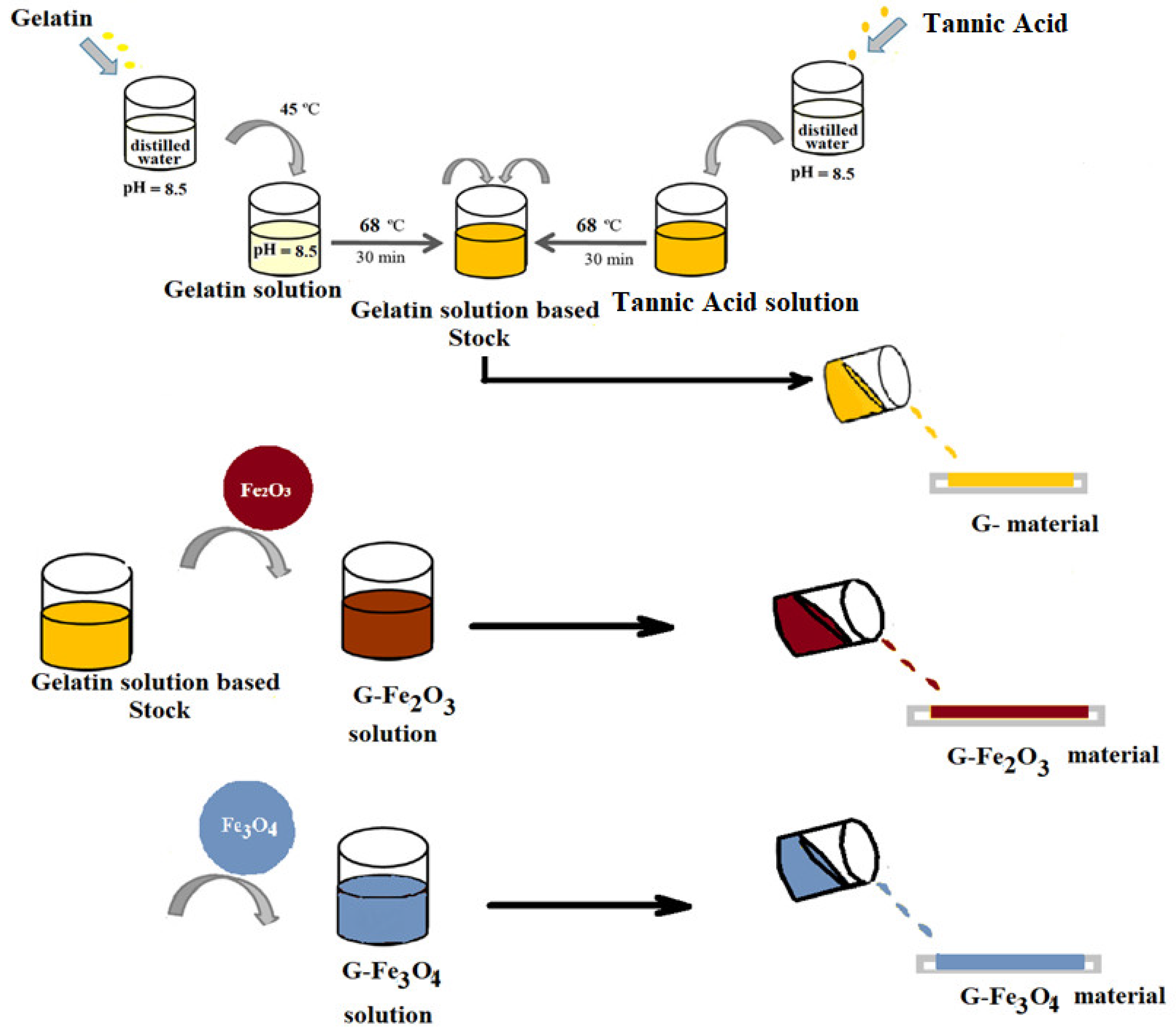
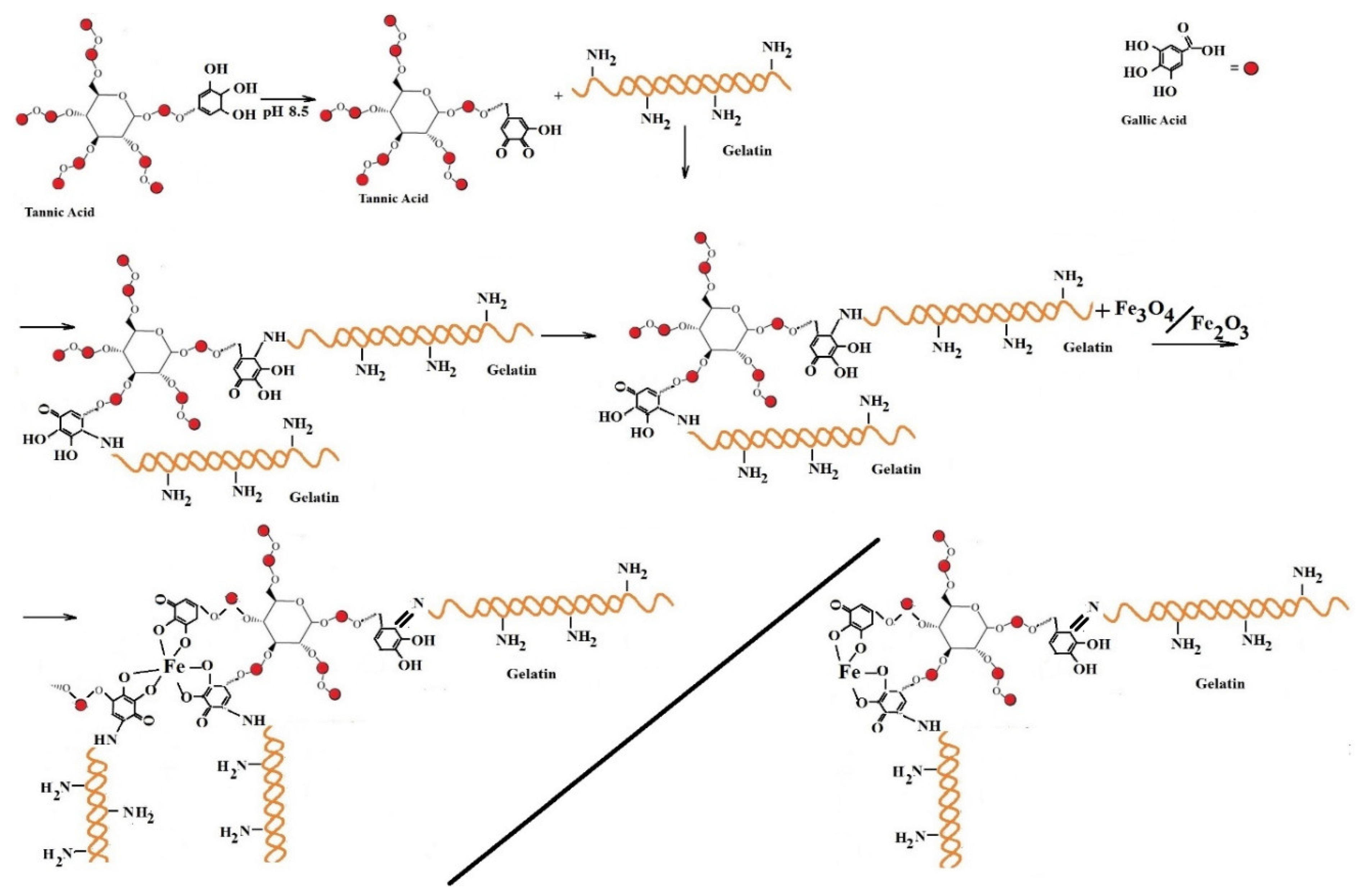

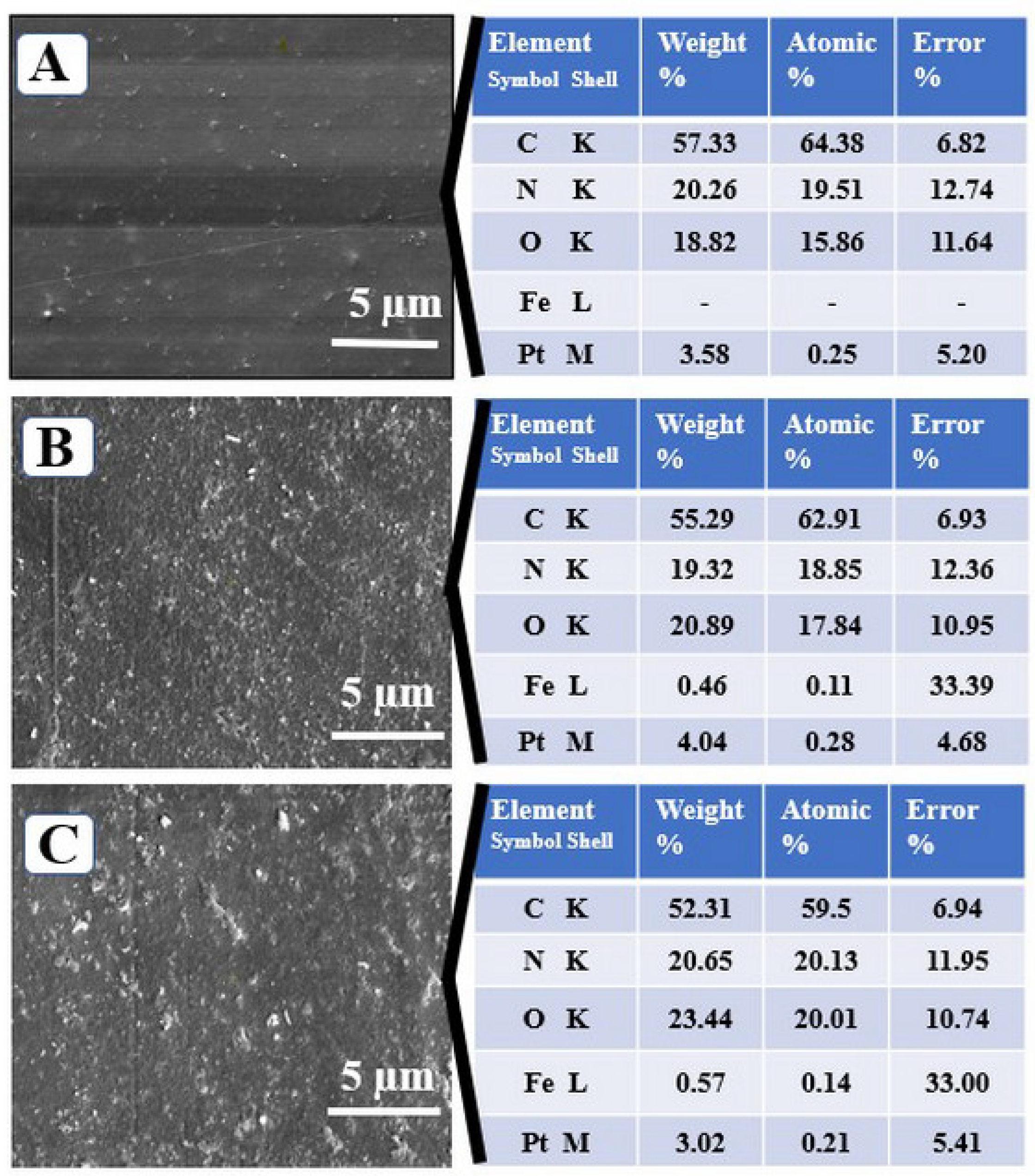

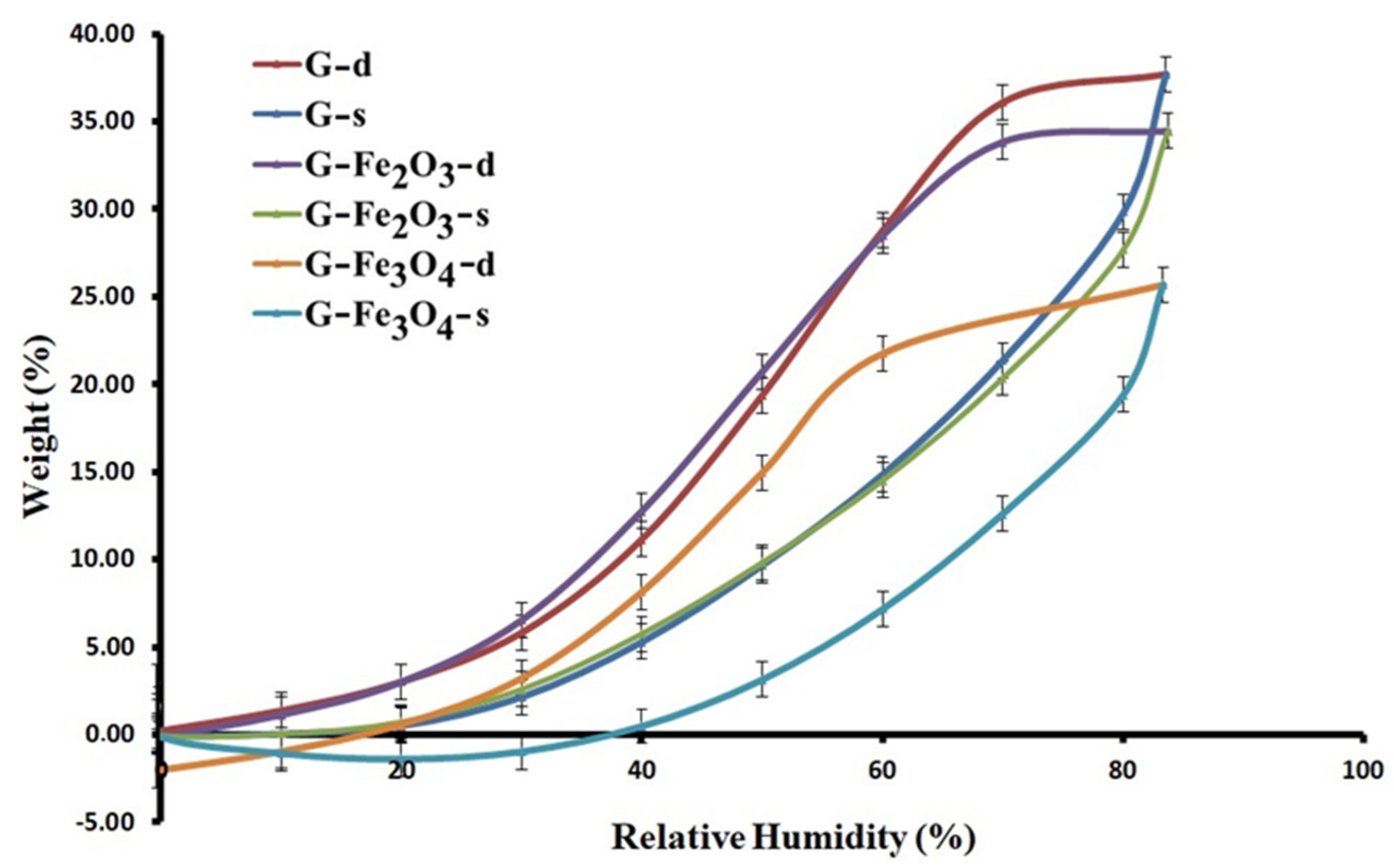

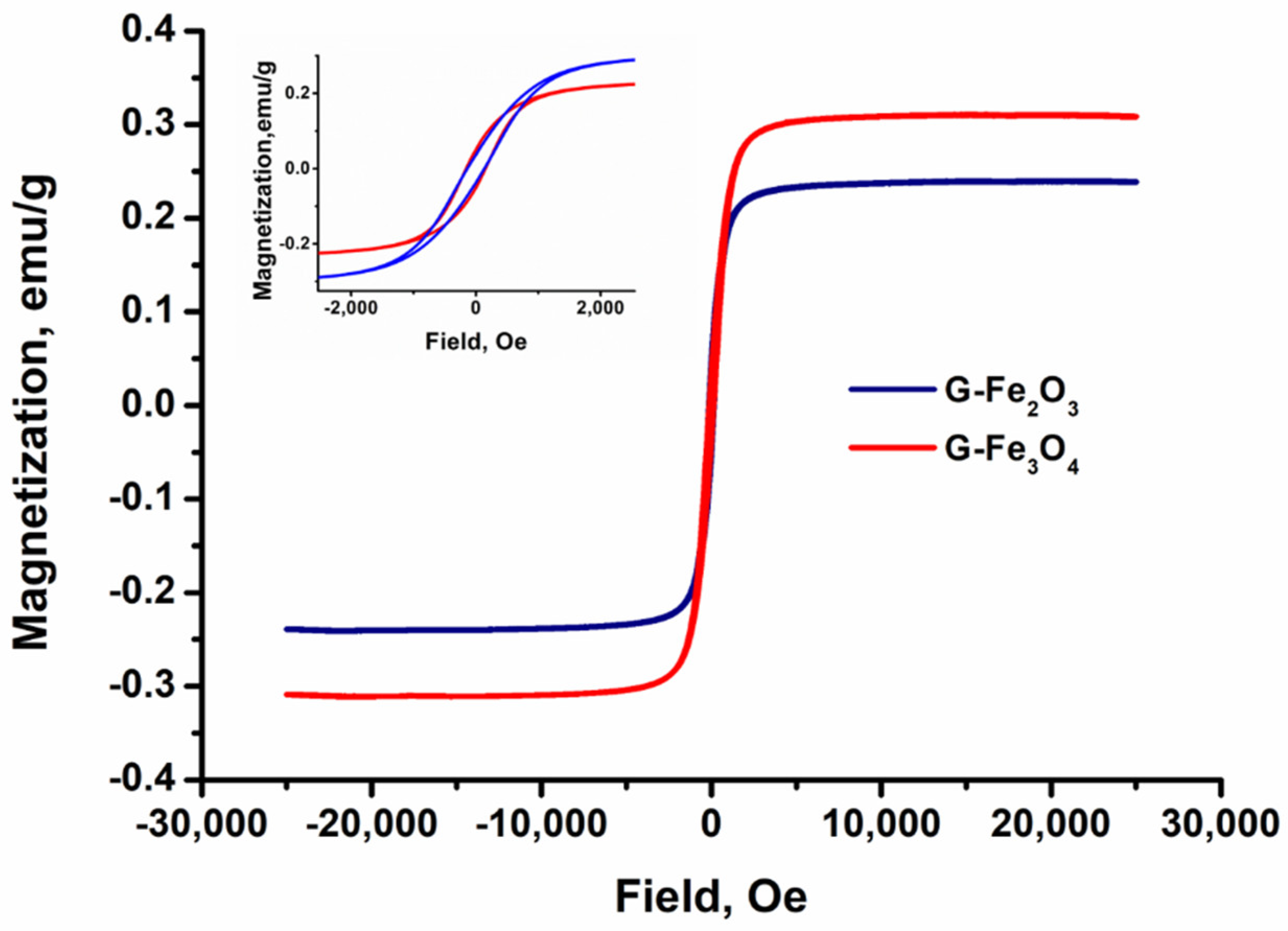
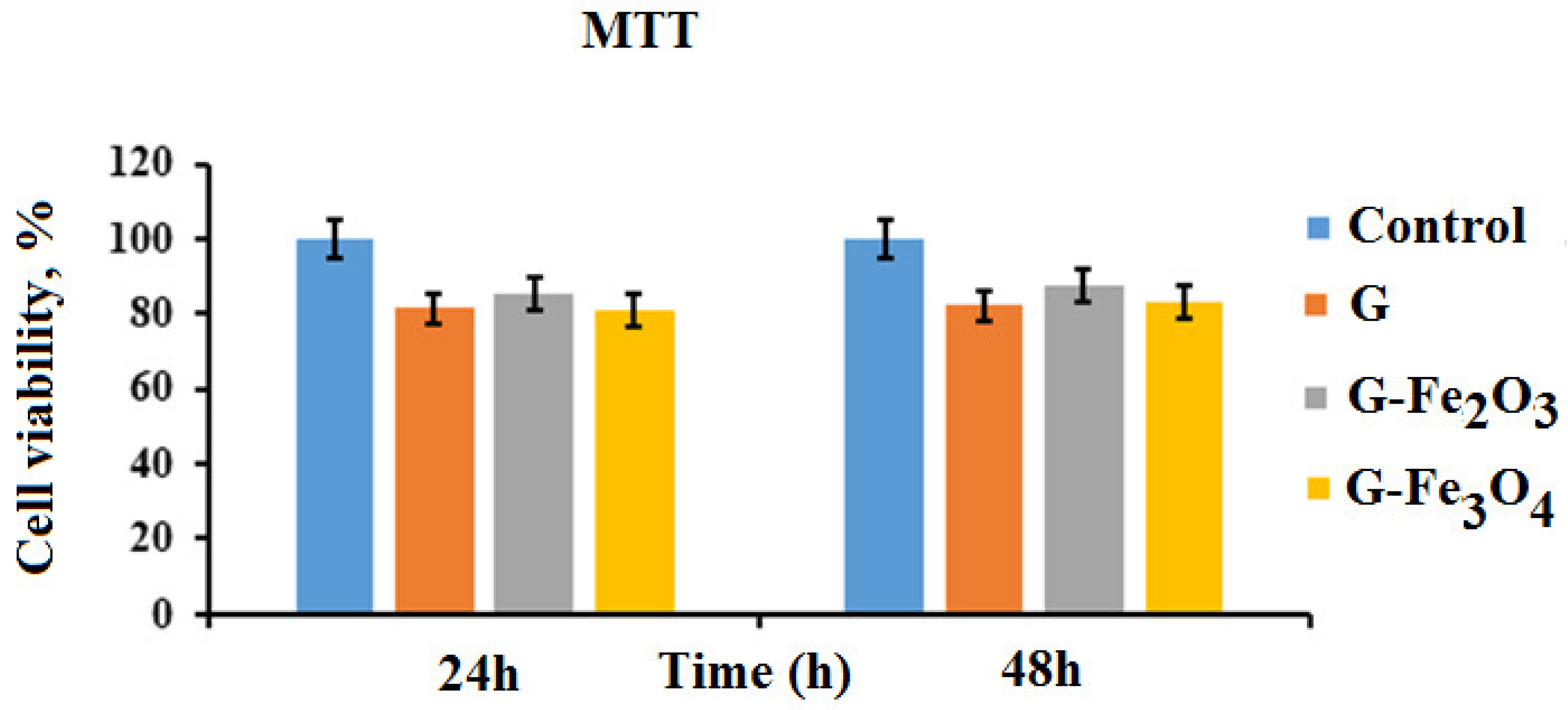
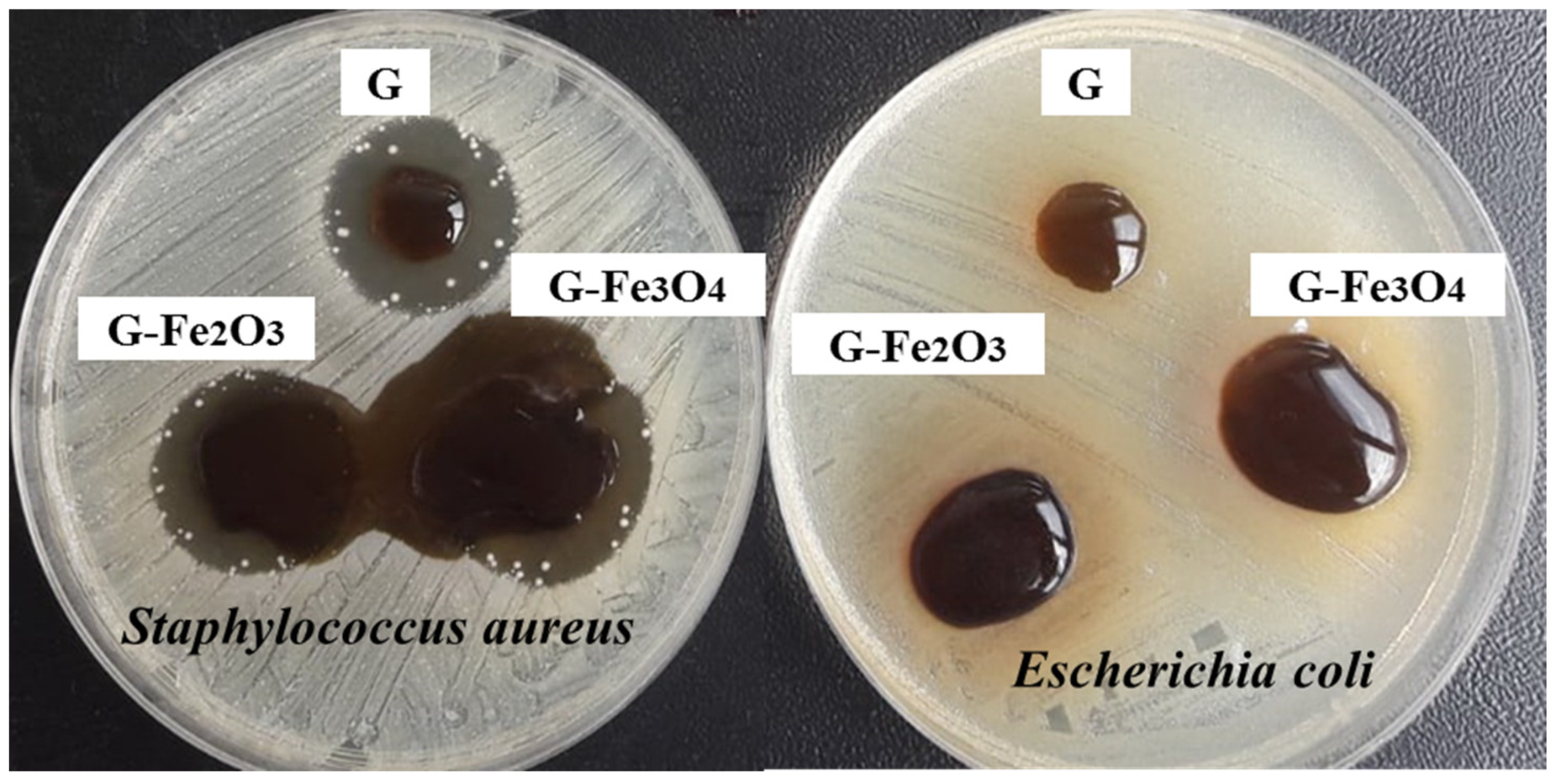
| Samples | Contact Angle | Wa (mN/m) | γsv (mN/m) | γpsv (mN/) | γdsv (mN/m) | γSL (mN/m) | |
|---|---|---|---|---|---|---|---|
| Water | Ethylene Glycol | ||||||
| G | 87.39 ± 0.15 | 45.81 ± 0.17 | 76.1 | 48.31 | 0.66 | 47.65 | 45.00 |
| G–Fe2O3 | 115.17 ± 0.26 | 50.84 ± 0.21 | 41.83 | 123.36 | 15.02 | 108.33 | 43.60 |
| G–Fe3O4 | 114.33 ± 0.19 | 48.15 ± 0.13 | 42.80 | 125.60 | 15.62 | 109.98 | 43.69 |
| Sample | Young’s Modulus (MPa) × 103 | Elongation at Break (%) | Tensile Strength (MPa) | Toughness (MJ/m3) |
|---|---|---|---|---|
| G | 5.12 | 8.44 | 39.94 | 68.77 |
| G–Fe3O4 | 3.35 | 21.88 | 17.95 | 27.15 |
| G–Fe2O3 | 0.30 | 63.27 | 3.05 | 2.97 |
| Samples | Weight (%) |
|---|---|
| G | 37.70 ± 0.17 |
| G–Fe3O4 | 34.46 ± 0.12 |
| G–Fe2O3 | 25.79 ± 0.09 |
| Samples | K1*, Mt/M∞ < 0.5 | K2*, Mt/M∞ > 0.5 | l (cm) | D1 = K1πl2/16 (cm2/s) | D2 = −K2l2/π2 (cm2/s) |
|---|---|---|---|---|---|
| G | 4.03 × 10−4 | −0.00156 | 0.1 | 7.91 × 10−7 | 1.58 × 10−6 |
| G–Fe3O4 | 3.17 × 10−4 | −0.00165 | 0.1 | 6.22 × 10−7 | 1.67 × 10−6 |
| G–Fe2O3 | 2.95 × 10−4 | −0.00143 | 0.1 | 5.78 × 10−7 | 1.45 × 10−6 |
| Sample | Coercivity (Hc) (Oe) | Saturation Magnetization (Ms) emu/g |
|---|---|---|
| G–Fe2O3 | 15.07 × 10−3 | 5.61 |
| G–Fe3O4 | 14.15 × 10−3 | 9.38 |
| Materials | Inhibition Zone Diameter (mm) | |
|---|---|---|
| S. aureus ATCC 25923 | E. coli ATCC25922 | |
| G (6 mm) | 25 ± 0.1155 * | 16 ± 0.4619 * |
| G–Fe2O3 (6 mm) | 29.3 ± 0.7513 * | 20.93 ± 0.636 * |
| G–Fe3O4 (6 mm) | 38.2 ± 0.8718 * | 29.13 ± 0.3528 * |
| Gentamycin 10 ug | 19–26 ** | |
Publisher’s Note: MDPI stays neutral with regard to jurisdictional claims in published maps and institutional affiliations. |
© 2022 by the authors. Licensee MDPI, Basel, Switzerland. This article is an open access article distributed under the terms and conditions of the Creative Commons Attribution (CC BY) license (https://creativecommons.org/licenses/by/4.0/).
Share and Cite
Drobota, M.; Vlad, S.; Gradinaru, L.M.; Bargan, A.; Radu, I.; Butnaru, M.; Rîmbu, C.M.; Ciobanu, R.C.; Aflori, M. Composite Materials Based on Gelatin and Iron Oxide Nanoparticles for MRI Accuracy. Materials 2022, 15, 3479. https://doi.org/10.3390/ma15103479
Drobota M, Vlad S, Gradinaru LM, Bargan A, Radu I, Butnaru M, Rîmbu CM, Ciobanu RC, Aflori M. Composite Materials Based on Gelatin and Iron Oxide Nanoparticles for MRI Accuracy. Materials. 2022; 15(10):3479. https://doi.org/10.3390/ma15103479
Chicago/Turabian StyleDrobota, Mioara, Stelian Vlad, Luiza Madalina Gradinaru, Alexandra Bargan, Iulian Radu, Maria Butnaru, Cristina Mihaela Rîmbu, Romeo Cristian Ciobanu, and Magdalena Aflori. 2022. "Composite Materials Based on Gelatin and Iron Oxide Nanoparticles for MRI Accuracy" Materials 15, no. 10: 3479. https://doi.org/10.3390/ma15103479
APA StyleDrobota, M., Vlad, S., Gradinaru, L. M., Bargan, A., Radu, I., Butnaru, M., Rîmbu, C. M., Ciobanu, R. C., & Aflori, M. (2022). Composite Materials Based on Gelatin and Iron Oxide Nanoparticles for MRI Accuracy. Materials, 15(10), 3479. https://doi.org/10.3390/ma15103479








